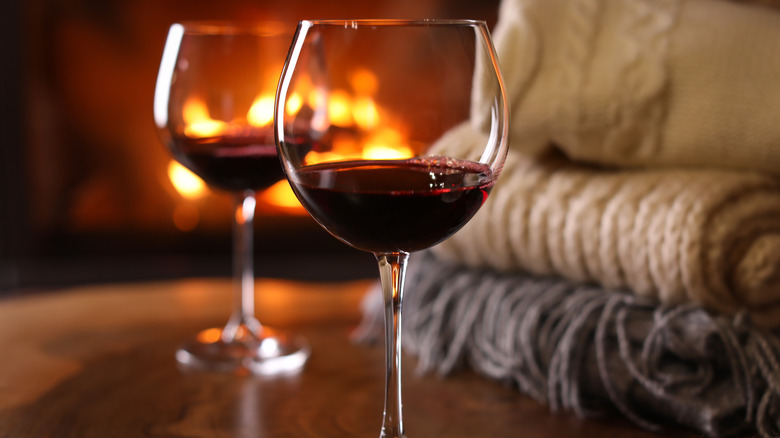How To Choose The Perfect Winter Wine
Winter's arrival doesn't only signal a change in the seasons, it can also have an impact on your diet and appetite. If you find yourself craving heartier meals during the cold months, you're not alone. Everyday Health explains that cold temperatures may trigger a biological response in people that harkens back to a time when preparing for harsh weather entailed packing on the pounds. Increased cravings for calorie-dense foods may also be linked to the lack of sunshine during the winter season. Exposure to sunlight releases serotonin, a hormone that floods the brain with good feelings and decreases stress. The same response is seen when a person consumes carbohydrates, which may explain certain winter food cravings.
Your choice of alcohol can also be affected by the weather outside, particularly when it comes to wine. According to RayLen Vineyards & Winery, most people have extremely specific ideas regarding winter wine selection. Many people prefer sweeter wines this time of year to accompany their favorite holiday treats. Winter wine aficionados also prefer richer, more robust flavors replete with notes of chocolate and nuts when imbibing in wintry weather. In order to choose the best selection for your palate, you must first understand the nature of seasonal wines.
Navigating seasonal wine selection
House of Townend provides some insight into the seasonality of different wines. While summer is associated with crisp, refreshing selections, winter is all about a full-body texture and warming sensation. These qualities are inherent in many red wines, which also pair well with heartier food selections, which are prominent during the chilliest months. White wine is also acceptable during winter, provided that it has rich, deep notes of oak and caramel and a fuller-bodied texture, though lighter white varietals can meet the moment if they're textural.
To this end, Forbes looked at several reds and whites ideal for the winter season. When it comes to red wine, Château Lassègue Saint-Émilion Grand Cru is a Bordeaux with a delicate tannin presence and an orchard's-worth of berry notes. There's also Primus Carménère, a "toasty" red characterized by fruity notes of stonefruit and a spicy, smoky finish. As for white winter wines, Hess Select Pinot Gris from California has a much fuller body than its Alsatian counterparts that is beautifully offset by intense fruity flavors reminiscent of peaches and pears. Besides seasonality, there are some other factors to consider when making your wine selection.
How to make the best selection for the winter months
Wine preferences vary, but knowledge of essential characteristics is crucial to your selection. According to Marketview Liquor, mouthfeel is a major consideration when it comes to the body of a wine. Besides red wine, wine derived from grapes grown in warm climates tend to have the fullest bodies, which makes them perfect for cold weather. As for acidity, low-acid selections offer a deeper, more complex flavor than tart, highly acidic wines. Because a higher alcohol content creates an even stronger warming sensation, a bottle with higher alcohol by volume is just the thing to warm your bones.
Along with evaluating the characteristics, you should also know the ins and outs of wine tasting. While intimidating to novices, Wine Enthusiast offers tips on how to get the most out of the practice. Visually assess the wine in the glass from multiple angles to judge its appearance. Next, swirl the glass to check for the presence of "legs," which are streaks of liquid that roll down the inside of the glass. Evaluate the scent of the wine by gently swirling the glass again, holding it under your nose, and taking multiple quick sniffs. Lastly, taste the wine, which should be done by sipping the liquid from the glass with a pulling motion. The best selections will have a good balance of aromas and flavors, along with a pleasant finish on the tongue. Tasting will help develop your palate, according to Wine Folly.


